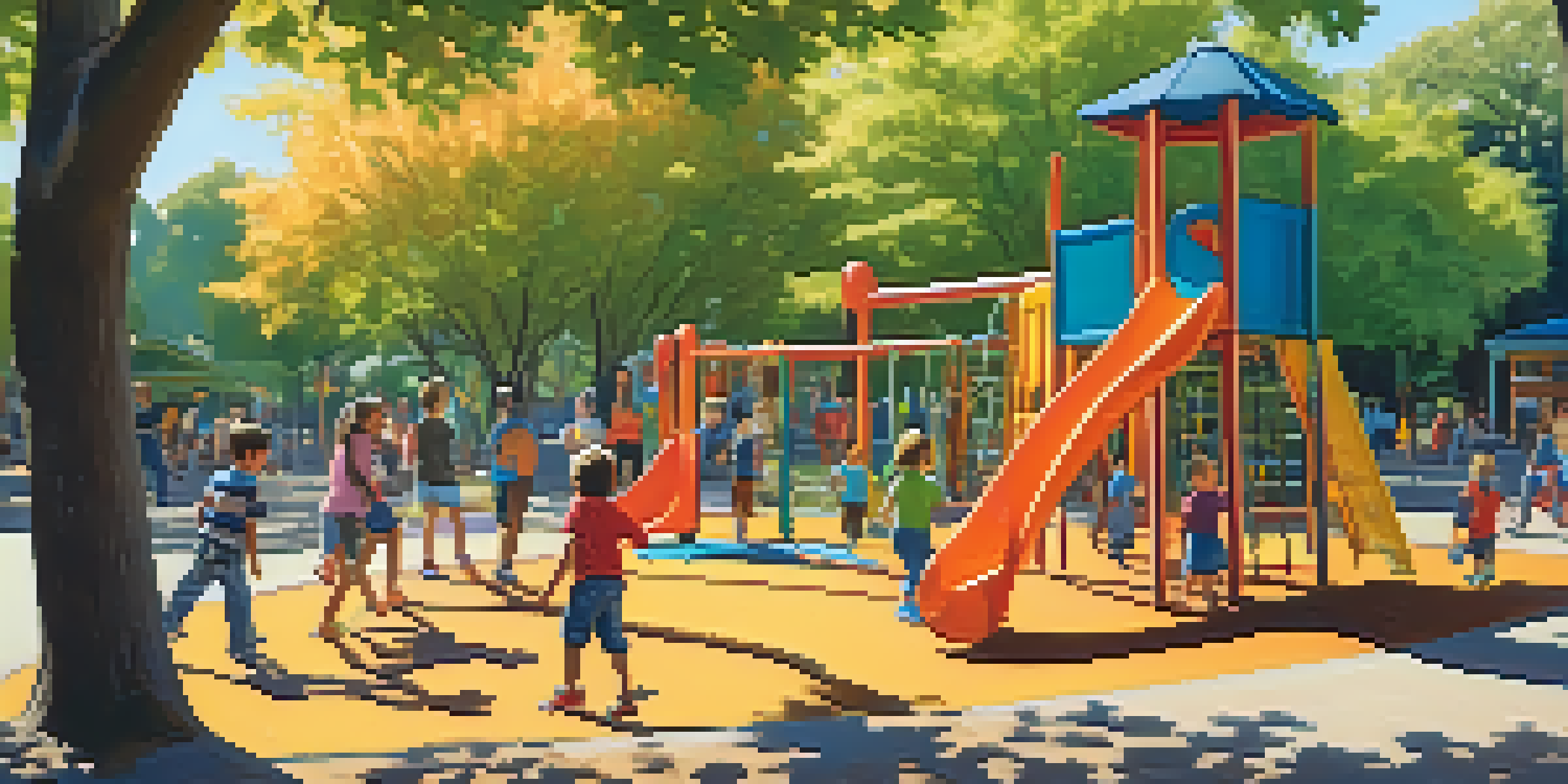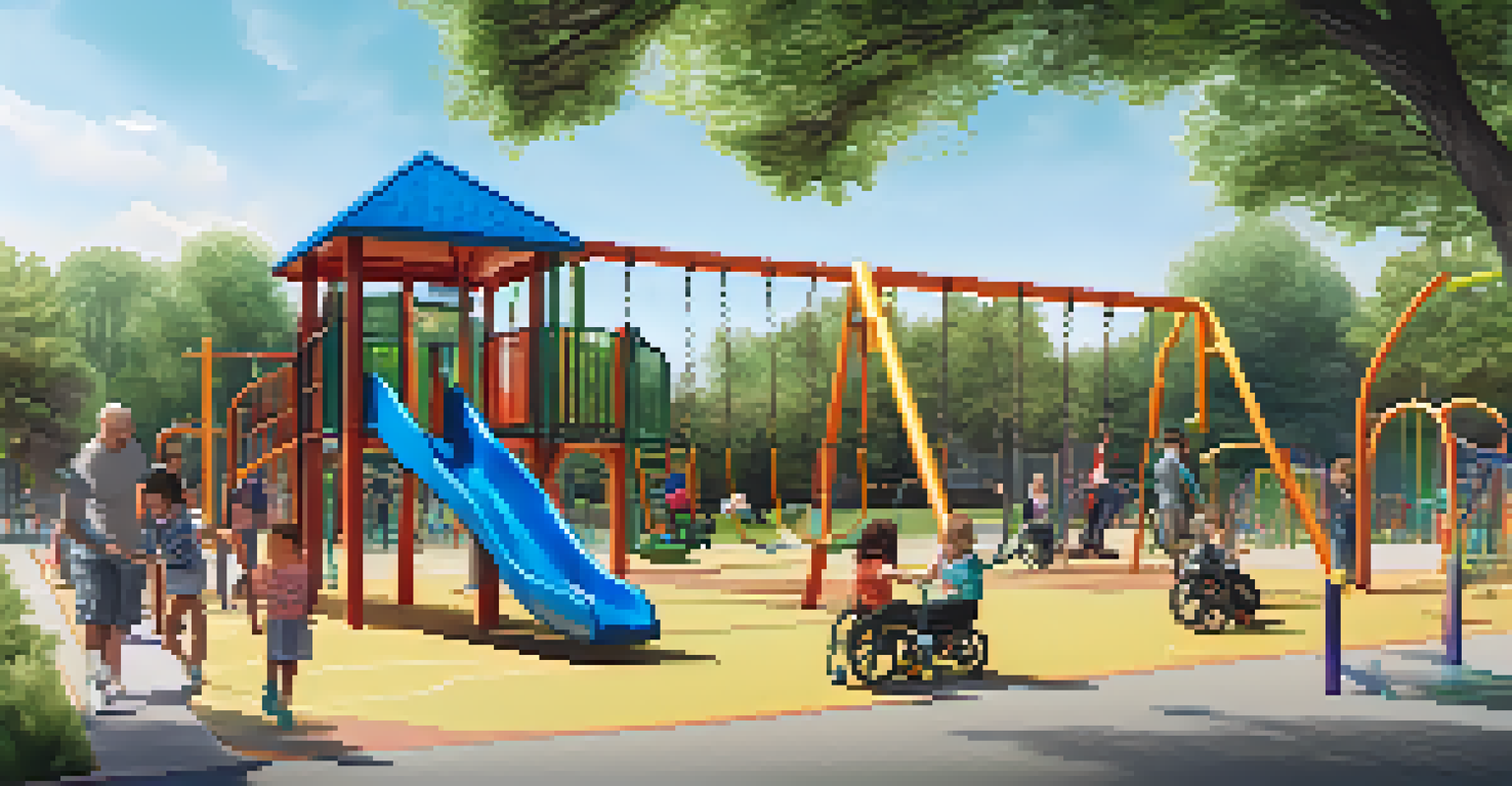The Importance of Playgrounds in Community Parks

Playgrounds Foster Community Interaction and Connection
Playgrounds serve as vital hubs where families and neighbors can gather, creating a sense of community. When children play, parents often engage in conversations, fostering friendships that extend beyond the playground. This interaction helps build social networks, making neighborhoods feel more connected and supportive.
Play is the highest form of research.
Moreover, these spaces encourage diverse interactions among people from different backgrounds. As kids swing, slide, and climb, adults share stories and experiences, breaking down barriers and building understanding. Community bonding through play can lead to a stronger, more resilient neighborhood.
In essence, playgrounds are more than just play areas; they are social platforms that enhance community ties. By investing in these spaces, local governments can promote a sense of belonging and reduce isolation among residents. After all, a connected community is a happier community.
Promoting Physical Health Through Active Play
One of the most significant benefits of playgrounds is their role in promoting physical health among children. Regular play helps kids develop essential motor skills, coordination, and strength, laying the foundation for a healthy lifestyle. Climbing, running, and jumping are not just fun; they’re excellent forms of exercise.

Additionally, encouraging outdoor play helps combat rising concerns about childhood obesity. When children have access to safe and engaging playgrounds, they are more likely to choose active play over sedentary activities like video games. This simple shift can significantly impact their overall health and well-being.
Community Bonds Through Play
Playgrounds serve as essential gathering places that foster social connections and strengthen neighborhood ties.
Moreover, active play also benefits mental health by reducing stress and anxiety levels. As children engage in play, they release endorphins, the body's natural mood lifters. A well-designed playground, therefore, not only promotes fitness but also nurtures happier and healthier kids.
Playgrounds Enhance Cognitive Development in Children
Playgrounds are essential for cognitive development, offering children opportunities to explore and learn through play. When kids engage in imaginative play, they develop critical thinking and problem-solving skills. For instance, figuring out how to navigate a climbing structure encourages strategic thinking and planning.
The best way to predict the future is to create it.
Furthermore, playgrounds often include interactive features that spark curiosity and creativity. From musical instruments to sensory gardens, these elements stimulate a child’s mind and promote exploratory learning. Such environments encourage children to ask questions and discover answers, laying the groundwork for lifelong learning.
In short, playgrounds are classrooms without walls, where learning happens organically. They provide a unique blend of physical and mental challenges that can prepare children for academic success. By prioritizing these spaces, communities can contribute to the holistic development of their youth.
Encouraging Inclusive Play for All Abilities
Modern playgrounds are increasingly designed with inclusivity in mind, ensuring that children of all abilities can play together. Adaptive equipment, like wheelchair-accessible swings and sensory play panels, allows everyone to participate and have fun. This inclusivity fosters a sense of belonging and acceptance among kids, regardless of their physical or cognitive challenges.
When children play together, they learn valuable social skills such as empathy, cooperation, and respect for differences. These lessons are crucial in shaping how they view and interact with the world. Playgrounds that promote inclusivity help dismantle stereotypes and foster friendships that might not otherwise develop.
Physical and Mental Health Benefits
Active play on playgrounds promotes physical health and enhances mental well-being by reducing stress and anxiety.
As communities embrace inclusive playground designs, they send a powerful message about the importance of diversity and acceptance. Investing in adaptable play areas not only benefits children with disabilities but enriches the experiences of all children, promoting a culture of inclusivity.
The Role of Playgrounds in Child Emotional Development
Playgrounds play a crucial role in emotional development by providing children with a safe space to express themselves. Through play, children can explore their feelings, manage stress, and develop coping skills. Whether they’re learning to negotiate turns on the slide or navigating friendships, every interaction contributes to their emotional intelligence.
Moreover, outdoor play fosters resilience as children encounter challenges and learn to overcome them. Climbing to the top of a jungle gym or attempting a daring jump encourages risk-taking and builds confidence. These experiences are essential for developing a growth mindset, where children learn to view challenges as opportunities.
By prioritizing emotional development through play, communities can raise well-rounded individuals. Playgrounds, therefore, are not just places for physical activity; they are essential environments for nurturing emotional well-being and personal growth.
Environmental Benefits of Playgrounds in Community Parks
Community parks that feature playgrounds can also contribute positively to the environment. These green spaces often include trees, plants, and open areas that support local wildlife and enhance biodiversity. By integrating playgrounds into parks, communities can create an ecosystem that benefits both people and the planet.
Furthermore, well-maintained parks can help improve air quality and reduce urban heat. Green spaces act as natural air filters, absorbing pollutants and providing shade. This not only makes playgrounds more enjoyable but also promotes healthier living conditions for everyone in the community.
Economic Gains from Play Spaces
Investing in playgrounds not only boosts community engagement but also contributes to long-term economic vitality and health savings.
In essence, playgrounds within community parks offer a dual benefit: they provide a space for recreation while supporting environmental sustainability. This relationship underscores the importance of thoughtful planning when designing community spaces that serve multiple purposes.
The Economic Value of Investing in Playgrounds
Investing in playgrounds can lead to significant economic benefits for communities. Enhanced parks attract families and visitors, leading to increased foot traffic and local business patronage. When a neighborhood becomes known for its vibrant play areas, it can boost property values and overall economic vitality.
Moreover, playgrounds can reduce long-term healthcare costs by promoting healthier lifestyles among children. By encouraging active play, communities may see a decrease in obesity-related health issues, leading to lower healthcare expenditures. This preventative approach can ultimately save money for families and local governments alike.

Thus, the economic advantages of investing in playgrounds extend beyond immediate returns; they contribute to long-term community health and prosperity. By prioritizing these spaces, communities can reap both social and financial rewards, making playgrounds a wise investment.